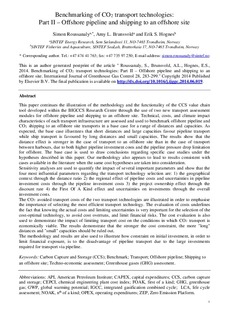| dc.contributor.author | Roussanaly, Simon | |
| dc.contributor.author | Brunsvold, Amy | |
| dc.contributor.author | Hognes, Erik Skontorp | |
| dc.date.accessioned | 2017-07-06T12:26:51Z | |
| dc.date.available | 2017-07-06T12:26:51Z | |
| dc.date.created | 2014-08-07T11:31:43Z | |
| dc.date.issued | 2014 | |
| dc.identifier.citation | International Journal of Greenhouse Gas Control. 2014, 28 283-299. | nb_NO |
| dc.identifier.issn | 1750-5836 | |
| dc.identifier.uri | http://hdl.handle.net/11250/2448083 | |
| dc.description.abstract | This paper continues the illustration of the methodology and the functionality of the CCS value chain tool developed within the BIGCCS Research Centre through the use of two new transport assessment modules for offshore pipeline and shipping to an offshore site. Technical, costs, and climate impact characteristics of each transport infrastructure are assessed and used to benchmark offshore pipeline and CO2 shipping to an offshore site transports in a base case for a range of distances and capacities. As expected, the base case illustrates that short distances and large capacities favour pipeline transport while ship transport is favoured by long distances and small capacities. The results show that the distance effect is stronger in the case of transport to an offshore site than in the case of transport between harbours, due to both higher pipeline investment costs and the pipeline pressure drop limitation for offshore. The base case is used to draw conclusions regarding specific case studies under the hypotheses described in this paper. Our methodology also appears to lead to results consistent with cases available in the literature when the same cost hypotheses are taken into consideration. Sensitivity analyses are used to quantify the impact of several important parameters and show that the four most influential parameters regarding the transport technology selection are: (1) the geographical context through the distance ratio, (2) the regional effect of pipeline costs and uncertainties in pipeline investment costs through the pipeline investment costs, (3) the project ownership effect through the discount rate, and (4) the First Of A Kind effect and uncertainties on investments through the overall investment costs. The CO2 avoided transport costs of the two transport technologies are illustrated in order to emphasise the importance of selecting the most efficient transport technology. The evaluation of costs underlines the fact that knowing the actual costs and limiting uncertainties is very important for the selection of the cost-optimal technology, to avoid cost overruns, and limit financial risks. The cost evaluation is also used to demonstrate the impact of limiting transport cost on the conditions in which CO2 transport is economically viable. The results demonstrate that the stronger the cost constraint, the more “long” distances and “small” capacities should be ruled out. The methodology and results are also used to illustrate how constraint on initial investment, in order to limit financial exposure, is to the disadvantage of pipeline transport due to the large investments required for transport via pipeline. Copyright © 2014 Elsevier Ltd. All rights reserved. | nb_NO |
| dc.language.iso | eng | nb_NO |
| dc.rights | Navngivelse 4.0 Internasjonal | * |
| dc.rights.uri | http://creativecommons.org/licenses/by/4.0/deed.no | * |
| dc.title | Benchmarking of CO2 transport technologies: Part II – Offshore pipeline and shipping to an offshore site | nb_NO |
| dc.type | Journal article | nb_NO |
| dc.type | Peer reviewed | nb_NO |
| dc.description.version | acceptedVersion | nb_NO |
| dc.rights.holder | Authors have copyright to postprint version | nb_NO |
| dc.source.pagenumber | 283-299 | nb_NO |
| dc.source.volume | 28 | nb_NO |
| dc.source.journal | International Journal of Greenhouse Gas Control | nb_NO |
| dc.identifier.doi | 10.1016/j.ijggc.2014.06.019 | |
| dc.identifier.cristin | 1145681 | |
| dc.relation.project | Norges forskningsråd: 193816 | nb_NO |
| cristin.unitcode | 7548,60,0,0 | |
| cristin.unitcode | 7569,83,0,0 | |
| cristin.unitname | Gassteknologi | |
| cristin.unitname | Fiskeriteknologi | |
| cristin.ispublished | true | |
| cristin.fulltext | postprint | |
| cristin.qualitycode | 2 | |

